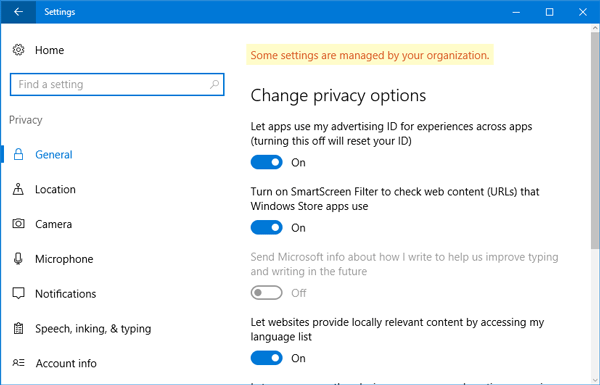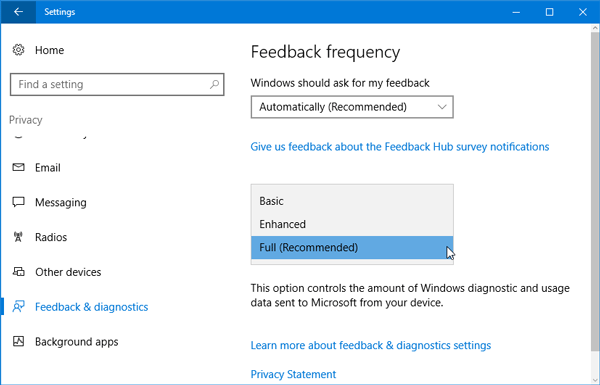If you see Some settings are hidden or managed by your organization message in Windows 11/10 Settings, then this post will show you how to troubleshoot the issue. They could be settings related to Windows Update, Lock Screen, Wallpaper background, Windows Defender, etc.
At times, Windows 11 or Windows 10 users may see a message Some settings are hidden or managed by your organization, when they go to change some options in the Settings app. You could see it in the Windows Update section, or anywhere in general, where you as a user are not allowed to change the setting. If you face this issue and want to resolve it, this post will show you the direction to work in.
Some Windows 11/10 Settings are greyed out

You could get the red text error message on any page of the Settings panel. You can get it while trying to change the desktop background or the lock screen background – or you could see it while trying to change the privacy settings as well. Since there is no single one-size-fits-all solution to this problem, you need to see what applies to your system and which works for you.
Some settings are managed by your organization
Before solving this problem, you should know the reason so that you can opt for the best solution quickly.
1] If you see a Cortana is disabled by company policy this post discusses the Cortana Group Policy & Registry settings.
2] If you see Some settings are managed by your organization message in Windows 10 Settings panel, you should know the following things. If your administrator has blocked any setting, you can get the message. If you have made any wrong changes in Registry Editor or Group Policy Editor, you can get the same error message. If some software like, say a Windows 10 Privacy Fixer Tool changed the setting, then too, you could see it. Try to remember the changes you made and see if you can reverse them using the same tool.
3] If you made no changes or do not remember making any, what you will have to do is identify the Registry key for Group Policy setting which affects you and change it.
MSDN has listed the Registry values and the respective Group Policy paths that can throw up such messages. You can also use the Group Policy Search (GPS) service which enables you to search for registry-based Group Policy settings used in Windows operating systems. Or else download the Group Policy Settings Reference Guide which lists the Group Policy setting against its corresponding registry key.
Take a look at the common ones which may affect your commonly used settings and see what may apply to your condition:
NoChangingWallpaper
Registry Editor Path:
SOFTWARE\Microsoft\Windows\CurrentVersion\Policies\ActiveDesktop
Group Policy Path: Administrative Templates > Control Panel > Personalization > Prevent changing desktop background
NoChangingLockScreen
Registry Editor Path:
SOFTWARE\Policies\Microsoft\Windows\Personalization
Group Policy Path:
Administrative Templates > Control Panel > Personalization > Prevent changing Lock screen image
NoLockScreen
Registry Editor Path:
SOFTWARE\Policies\Microsoft\Windows\Personalization
Group Policy Path:
Administrative Templates > Control Panel > Personalization > Do not display the Lock screen
NoThemesTab
Registry Editor Path:
SOFTWARE\Microsoft\Windows\CurrentVersion\Policies\Explorer
Group Policy Path:
Administrative Templates > Control Panel > Personalization > Prevent changing theme
NoDispScrSavPage
Registry Editor Path:
SOFTWARE\Microsoft\Windows\CurrentVersion\Policies\System
Group Policy Path:
Administrative Templates > Control Panel > Personalization > Prevent changing screen saver
NoChangingSoundScheme
Registry Editor Path:
SOFTWARE\Policies\Microsoft\Windows\Personalization
Group Policy Path:
Administrative Templates > Control Panel > Personalization > Prevent changing sounds
NoChangeStartMenu
Registry Editor Path:
SOFTWARE\Microsoft\Windows\CurrentVersion\Policies\Explorer
Group Policy Path:
Administrative Templates > Start Menu and Taskbar > Prevent users from customizing their Start Screen
LockedStartLayout
Registry Editor Path:
SOFTWARE\Policies\Microsoft\Windows\Explorer
Group Policy Path:
Administrative Templates > Start Menu and Taskbar > Start Layout
NoSetTaskbar
Registry Editor Path:
SOFTWARE\Microsoft\Windows\CurrentVersion\Policies\Explorer
Group Policy Path:
Administrative Templates > Start Menu and Taskbar > Prevent changes to Taskbar and Start Menu Settings
NoControlPanel
Registry Editor Path:
SOFTWARE\Microsoft\Windows\CurrentVersion\Policies\Explorer
Group Policy Path:
Administrative Templates > Control Panel > Prohibit access to Control Panel and PC settings
Don’t forget to find those values in two different places, i.e.,
- HKEY_CURRENT_USER
- HKEY_LOCAL_MACHINE
The solution is to remove those values using the Registry Editor after creating a Registry backup or a system restore point. However, sometimes, problems may not go away even after deleting those Registry values.
You could alternatively use the Group Policy Editor and check if the settings are enabled. If any of the settings mentioned above are enabled, try to set it to either “Not Configured.”
4] You can also remove all settings and policies that may have been applied. Create a system restore point and backup your registry first and then run the following command/s:
reg delete "HKCU\Software\Microsoft\Windows\CurrentVersion\Policies" /f reg delete "HKCU\Software\Microsoft\WindowsSelfHost" /f reg delete "HKCU\Software\Policies" /f reg delete "HKLM\Software\Microsoft\Policies" /f reg delete "HKLM\Software\Microsoft\Windows\CurrentVersion\Policies" /f reg delete "HKLM\Software\Microsoft\Windows\CurrentVersion\WindowsStore\WindowsUpdate" /f reg delete "HKLM\Software\Microsoft\WindowsSelfHost" /f reg delete "HKLM\Software\Policies" /f reg delete "HKLM\Software\WOW6432Node\Microsoft\Policies" /f reg delete "HKLM\Software\WOW6432Node\Microsoft\Windows\CurrentVersion\Policies" /f reg delete "HKLM\Software\WOW6432Node\Microsoft\Windows\CurrentVersion\WindowsStore\WindowsUpdate" /f
If you wish, you may reset all Group Policy settings to default.
5] If you see this message on your Windows Update Settings page, this post shows the Windows Update Group Policy & Registry settings you may need to take a look at.
6] If you receive this message when you have used a corporate Exchange account in your Mail app you need to remove it from the Mail app and use any other account. For your information, the same can appear in the wrong language and country or region settings.
7] At times, changing Windows 10 Telemetry settings have also know to throw up such messages. Open Settings (Win+I) > Privacy > Feedback & diagnostics. Here, you will get a label called “Send your device data to Microsoft.” Just expand the drop-down menu and select “Full (Recommended).”

If this option itself is grayed out and there is no way to change that option, you can use Group Policy Editor to make the same change. Press Win + R, type gpedit.msc and hit enter. Following that, navigate to the following path,
Computer Configuration > Administrative Templates > Windows Components > Data Collection and Preview Builds
Here, you should get the option called “Allow Telemetry.” Double click on that, select Enabled and choose “2 – Enhanced” from the drop-down menu. If that doesn’t solve your problem, select “3 – Full”.
8] See this post if you receive This operation has been canceled due to restrictions in effect on this computer message.
9] This post will help you if you receive Your Virus & threat protection is managed by your organization.
10] This post will help you if you receive Your organization has turned off automatic updates or Your organization has set some policies to manage updates messages.
11] See this post if you see For your security, some settings are managed by your system administrator message.
I hope something helps you.
Read: How to view Configured Windows Update Policies applied to your computer.
My registry has no Personalization option showing at all.
Allow telemetry drop down automatically changes to off(enterprise only)
Wish people would stop recommending gpedit.msc. This is only available on pro.
Here’s what worked for me to permit me to change the Lock Screen Image:
In Regedit, go to HKLMSOFTWAREMicrosoftPolicyManagerdefaultDeviceLock
Under this, click EnforceLockScreenAndLogonImage, and change policytype from 1 to 0
Also click EnforceLockScreenProvider, and change policytype from 1 to 0.
When someone tells u to “allow telemetry” they r obviously a MS shill!
Have people completely forgot the all the windows 10 privacy issues???They have never been resolved!Nothing has changed but most people seems to forgotten all about it…
Some of the registry hints (did i say some? most of ’em) leave out the main ingredient like the HKEY path, guess we can narrow them down to three as HKEY_CLASSES_ROOT is out.
Things like
”Registry Editor Path: SOFTWAREPoliciesMicrosoftWindowsExplorer”
only muddy the water with no hint of what to look for like START or whatever c’mon man
Why I don’t see “Data Collection and Preview Builds” in Group Policy Editor?
nice sir.. it worked i just deleted — what was in — ComputerHKEY_LOCAL_MACHINESOFTWAREPoliciesMicrosoftWindowsPersonalization .
” I didn’t deleted the main folder that is -personalisation” – just contains.
Thanks again !!!